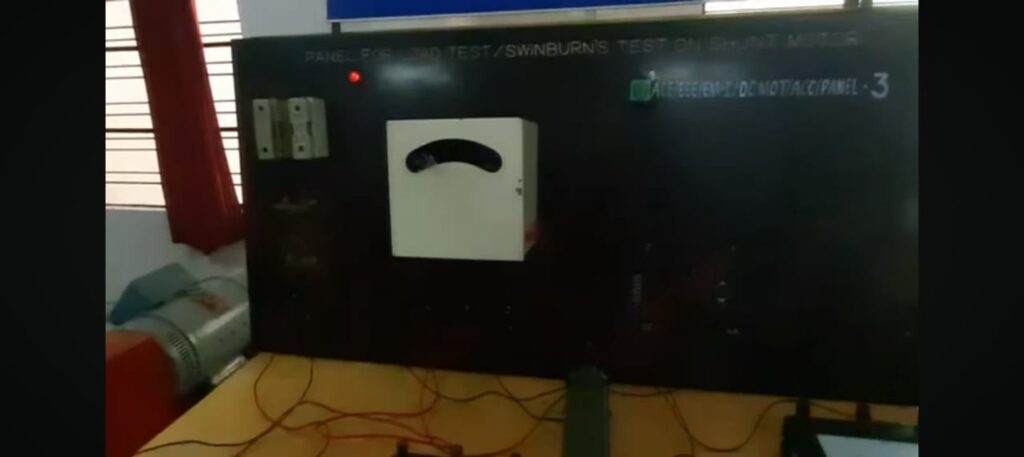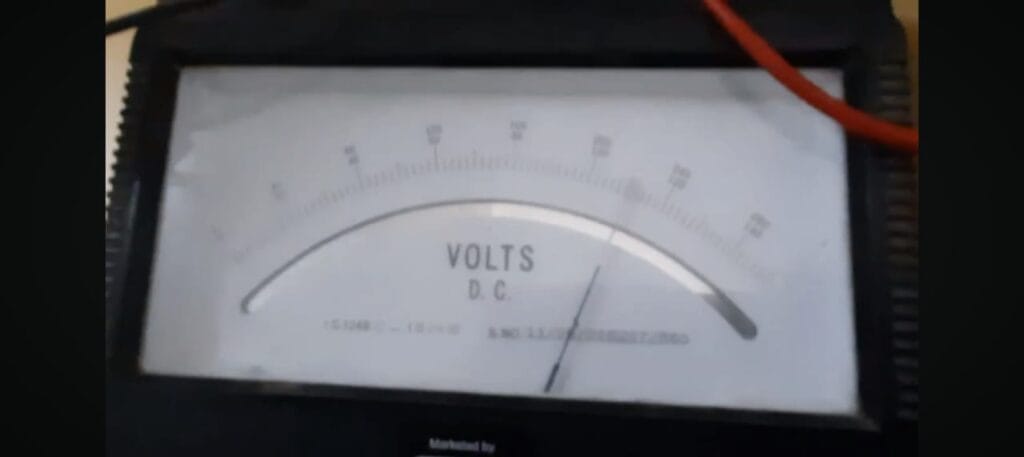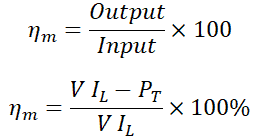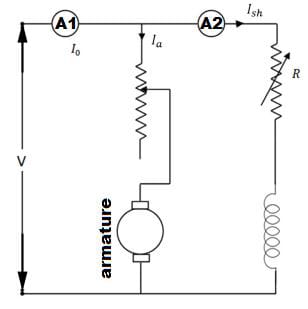Table of Contents
Complete Guide to Swinburne Test DC Machine
The Swinburne Test is a simple and useful method to check the performance of DC motors. It helps us know how much energy the motor uses and how efficient it is. This guide will explain everything in a very simple way. Let’s learn step by step!
1. Step-by-Step Procedure of Swinburne Test DC Machine
Step 1: Connect the DC motor to a DC power supply. Make sure the supply voltage matches the rated voltage of the motor.

Step 2: Connect the instruments properly. Place an ammeter in series with the armature to measure current. Connect a voltmeter across the motor terminals to measure voltage. Add a rheostat in series to control the supply current. Ensure tight and clean connections to avoid errors.

Step 3: Keep the motor running without a load. This is important because the Swinburne Test is a no-load test, used to measure constant losses only.

Step 4: Switch on the DC power supply slowly. Carefully adjust the rheostat to set the voltage across the motor equal to its rated value.
Step 5: Allow the motor to run at its rated speed. Take the readings of voltage (V), no-load current (I₀), and field current (If). If separate field winding is used, note that the current is separated.
Step 6: Record all measured values. Use these to calculate power input, field power, armature power, and constant losses.
Step 7: After noting the data, turn off the power supply. Disconnect the motor and instruments safely to avoid electric shock or damage.
2. Advantages and Disadvantages of the Swinburne Test DC Machine
Advantages:
- Simple Procedure: The Swinburne Test is easy to perform. It does not require any complex setup or heavy machinery, making it ideal for beginners and lab experiments.
- Low Power Consumption: Since the motor runs without any mechanical load, it consumes very little power during the test.
- Safe Operation: The test is conducted under no-load conditions, reducing the risk of mechanical stress and overheating.
- Quick Estimation: It provides a quick and efficient way to estimate motor efficiency and losses, which is useful for preliminary analysis.
- Cost-Effective: No need for heavy load arrangements like brake drums or load pulleys, which makes it cheaper to conduct.
Disadvantages:
- No Load Conditions Only: The Swinburne Test is not suitable for testing the motor under actual working (load) conditions. It does not show how the motor performs with varying loads.
- Temperature Effects Ignored: Since the motor is not operating under load, it does not get hot. This means the temperature rise and its effects on efficiency are not measured.
- Inaccurate for Machines with Variable Losses: If the machine has losses that change significantly with load (like stray load losses), this test might give incorrect results.
- Not Suitable for Series Motors: The test cannot be applied to DC series motors because they cannot run safely under no-load conditions.
- Measurement Errors: Even small inaccuracies in measurement (voltage, current, resistance) can cause large errors in calculating efficiency due to the nature of indirect estimation.
3. Equipment and Laboratory Setup
To perform the Swinburne Test accurately and safely, the following equipment and setup are required:
- DC Motor (Shunt Type): A DC shunt motor is preferred for this test because it can run safely under no-load conditions. The motor should be in good condition, with known ratings (voltage, current, speed).
- DC Power Supply: A regulated DC power source is necessary to supply the rated voltage to the motor. It should be able to handle the motor’s rated current without fluctuations.
- Voltmeter: A precise voltmeter is used to measure the voltage applied across the motor terminals. It should match the range of the motor’s rated voltage.
- Ammeter: An ammeter is connected in series to measure the total current drawn by the motor. A separate ammeter may also be used for the field circuit if the motor has a separate field winding.
- Rheostat (Variable Resistor): Used to gradually increase the voltage and limit the current when starting the motor. It also helps in fine adjustment of voltage to reach rated conditions.
- Connecting Wires: High-quality, well-insulated wires with proper thickness are required to connect all components. The wire gauge should match the current capacity of the motor.
- Safety Switches and Fuses: These provide protection from short circuits, overcurrent, or any accidental faults during testing. Circuit breakers or MCBs can also be used.
- Starter (Optional): A three-point or four-point starter may be used to protect the motor during startup by limiting the inrush current.
- Base or Mounting Platform: The motor and instruments should be mounted on a stable base or bench to ensure proper alignment and vibration-free operation.
Laboratory Conditions:
- Ensure the lab is clean and free of moisture.
- The test area should be well-ventilated to avoid heat accumulation.
- Adequate lighting must be provided for clear visibility of instruments and connections.
- Emergency shutdown systems and first-aid should be available in case of any mishap.
Having all these elements in place ensures that the Swinburne Test is performed safely, accurately, and professionally.
4. Efficiency Calculation Using Swinburne Test DC Machine
Formula:
Efficiency = (Output Power / Input Power) × 100%
First, find the losses:
- Iron Losses + Mechanical Losses = Constant Losses (from no-load test)
- Copper Loss = I²R (full-load current)
Then,
Output Power = Input Power – Losses
Finally, use the formula to get efficiency.

5. Swinburne Test vs Brake Test
The Swinburne Test and Brake Test are two commonly used methods to analyze the performance of DC motors. Each has its strengths and limitations, and the choice depends on the purpose of the test, the type of motor, and the available setup.
| Feature | Swinburne Test | Brake Test |
| Load Condition | No Load (motor runs without mechanical load) | Full Load (motor performs actual mechanical work) |
| Power Requirement | Low, as there is no load attached | High, due to mechanical loading and heat generation |
| Accuracy | Moderate, based on calculated losses | High, as performance is tested directly under load |
| Loss Measurement | Measures constant losses (iron + mechanical) only | Measures all types of losses, including stray and load-dependent losses |
| Thermal Behavior | Cannot simulate actual temperature rise | Can observe temperature rise under working conditions |
| Motor Wear | Minimal, since no mechanical stress is involved | Higher wear due to friction, heat, and torque |
| Equipment Needed | Basic instruments (ammeter, voltmeter, rheostat) | Requires brake drum, spring balance, torque arm, etc. |
| Time Efficiency | Fast and simple to perform | Time-consuming due to load setup and measurements |
| Risk Level | Very Low | Higher (possibility of overheating or overloading motor) |
| Applicability | Only for shunt and compound motors | Can be used for all types, including series motors |
Key Observations:
- Swinburne Test is an indirect method. It estimates efficiency based on no-load measurements and calculates copper losses under assumed full-load conditions. It is suitable when speed, cost, and safety are top priorities.
- Brake Test is a direct method. It measures actual input and output power under full load, thus giving highly accurate results. It is ideal when precise performance evaluation is needed.
Which Test Should You Choose?
- Choose the Swinburne Test if you want a quick, low-risk evaluation of motor efficiency without needing heavy loading equipment. It is often used in labs and basic maintenance settings.
- Choose the Brake Test if you need to know exactly how a motor behaves under real working conditions. It is suitable for industrial applications, quality control, and performance benchmarking.
In conclusion, both tests are valuable tools in electrical engineering. The Swinburne Test provides a simplified and safe estimate, while the Brake Test delivers direct, detailed data at the cost of higher setup complexity and risk.
6 . Safety Precautions in Swinburne Test DC Machine
Performing the Swinburne Test safely is very important to avoid accidents and damage to the equipment. Here are the full and detailed safety precautions to follow during the test:
- Check All Connections Carefully: Before switching on the power supply, inspect all wires and instrument connections. Loose or wrong connections can cause short circuits or wrong readings.
- Use Appropriate Fuses and MCBs: Always use correctly rated fuses and miniature circuit breakers (MCBs) in the circuit. They help protect against overcurrent, short circuits, or equipment failure.
- Avoid Wet Hands or Moisture: Never touch electrical components or terminals with wet hands. Keep the testing area dry. Water increases the risk of electric shock.
- Keep Flammable Materials Away: Do not keep any flammable liquids, cloths, or paper near the testing setup. Sparks or overheating may cause a fire.
- Turn Off Power Immediately After the Test: Once the test is complete, switch off the power supply immediately. Do not leave the motor connected unnecessarily.
- Never Leave the Motor Running Unattended: Always monitor the motor while it is running. Even under no-load conditions, unexpected faults like sparking, noise, or heating may occur.
- Proper Grounding: Ensure that all instruments and the motor body are properly grounded to avoid shock hazards and static charge buildup.
- Wear Protective Gear: In a professional lab, it is advisable to wear rubber gloves, safety shoes, and protective glasses, especially if you’re working near high-current setups.
- Keep Emergency Equipment Ready: Always have a fire extinguisher, first-aid box, and an emergency shutdown system nearby in case of an accident.
- Follow Lab Rules and Supervision: Always follow your lab’s standard safety rules and perform the test under the supervision of a qualified instructor or engineer if you are a beginner.
Following these precautions not only ensures your safety but also helps protect the equipment and ensures reliable results during the Swinburne Test.
7. Applications of the Swinburne Test DC Machine
The Swinburne Test is widely used in many areas because it is simple, safe, and does not need heavy mechanical loads. Here are the main applications explained in detail:
- Factories and Industrial Plants: Industries use the Swinburne Test for regular motor inspection and preventive maintenance. It helps check motor health without stopping production. Since the motor runs without a load, this test is quick and energy-saving.
- Motor Manufacturing Units: Motor manufacturers perform this test during the final inspection stage to make sure the motor meets its efficiency and performance targets. It also helps identify any defects before shipping to customers.
- Repair and Service Workshops: When motors come in for repair, service technicians use the Swinburne Test to check if the motor is fixed properly and whether it is safe and efficient to use again. It gives quick feedback without applying any mechanical load.
- Engineering Colleges and Training Centers: The test is popular in labs for educational purposes. Students learn about DC motor performance, energy losses, and how to calculate efficiency. Since there is no heavy machinery involved, the test is safe and easy to perform.
- Research and Development (R&D): In R&D labs, engineers use this test to study newly designed DC motors. It helps them analyze how efficiently the motor works at no-load conditions before testing under full load.
- Quality Control Departments: Before delivering motors to customers, manufacturers perform this test as a quality check. It helps verify that the motor is running smoothly, drawing the correct current, and meeting rated performance.
8. Circuit Diagram and Connection Layout
Below is a detailed and complete circuit diagram for performing the Swinburne Test on a DC shunt motor:
+——————– Rheostat ——————+
| |
DC Supply (+) — Ammeter — Armature — DC Motor — Voltmeter — DC Supply (-)
| |
Field Coil Field Rheostat
Explanation of Connections:
- DC Power Supply: Provides the required voltage for the test. The polarity must match the motor rating.
- Ammeter: Connected in series with the armature to measure total current drawn.
- Rheostat: Connected in series with the armature circuit to control current and voltage gradually. Prevents sudden surges during startup.
- Field Coil and Field Rheostat: Connected in parallel (shunt) with the armature. The field rheostat helps adjust the field current.
- Voltmeter: Connected across the motor terminals to measure the applied voltage accurately.
Important Notes:
- Always use correct electrical symbols for each component in a drawn circuit diagram.
- Ensure the rheostat can handle the full armature current.
- If a separate field winding is used, connect a separate ammeter in the field circuit to measure field current.
- Proper fusing and safety switches should be included in the actual setup (not shown here) to protect the system.
This layout helps ensure accurate, safe, and standardized testing of motor efficiency using the Swinburne method.
9. Iron and Copper Loss Calculations
In DC motors, energy losses occur due to different reasons. Understanding these losses helps in estimating motor efficiency accurately. Losses are generally divided into constant losses and variable losses.
Iron Loss (Core Loss):
- Iron loss occurs in the armature core due to alternating magnetic fields when the motor runs.
- It includes hysteresis loss (due to magnetization cycles in the core) and eddy current loss (due to circulating currents in the core).
- These losses remain constant as they depend on voltage and frequency, not on load.
- Measured during the no-load condition in the Swinburne Test DC Machine.
Mechanical Loss:
- Caused by friction in bearings and windage loss (air resistance as the rotor rotates).
- Like iron loss, mechanical loss is independent of load and thus considered constant.
Total Constant Loss = Iron Loss + Mechanical Loss
Copper Loss (Variable Loss):
- Caused by the resistance of motor windings when current flows through them.
- Calculated using the formula: Copper Loss = I² × R, where:
- I = Current through the winding
- R = Resistance of the winding
- There are two components:
- Armature Copper Loss: Iₐ² × Rₐ
- Field Copper Loss: I_f² × R_f (if separate field winding exists)
- Copper loss increases with load and is therefore called a variable loss.
Total Loss = Constant Loss + Copper Loss
= (Iron + Mechanical) + (I² × R)
Example:
Suppose:
- No-load input = 300 W
- Field Power = 100 W → Constant Loss = 300 – 100 = 200 W
Now, at full-load:
- Full-load current = 10 A
- Armature resistance Rₐ = 0.5 Ω → Armature Copper Loss = (10)² × 0.5 = 100 × 0.5 = 50 W
Total Loss at full-load = Constant Loss + Copper Loss = 200 + 50 = 250 W
Knowing total losses, you can subtract from the input power to get the output and find efficiency.
This detailed understanding of losses helps in accurate motor evaluation using the Swinburne Test DC Machine.
10. Swinburne Test Result Interpretation
After performing the Swinburne Test and collecting all readings, the next important step is to interpret the results correctly. This helps in identifying the motor’s health and performance.
Key Points to Check:
- Efficiency Level:
- Calculate efficiency using the formula: Efficiency = (Output Power / Input Power) × 100%.
- If the efficiency is above 85%, it generally means the motor is in good condition.
- Lower efficiency may indicate internal issues or high losses.
- Constant Losses:
- Evaluate the iron and mechanical losses recorded during the no-load test.
- These should remain within expected design limits. Sudden increase in these values may point to wear or aging of components (e.g., bearings or armature core issues).
- Copper Losses at Full Load:
- Use the full-load current and armature resistance to compute copper losses (I²R).
- If copper losses are too high, it may indicate increased resistance due to heating, poor connections, or winding damage.
- Rated Current:
- Compare the current drawn by the motor with its rated current.
- If it draws more current than rated, it may be due to internal short circuits, misaligned brushes, or armature faults.
- Voltage Stability:
- Check if the voltage across the motor remains close to its rated value during the test.
- Large voltage drops can affect test accuracy and indicate power supply or connection issues.
Diagnosing Motor Health:
- Healthy Motor:
- Efficiency ≥ 85%
- Losses within normal range
- Motor draws rated current
- No abnormal heating or noise
- Unhealthy Motor:
- Efficiency below 85%
- Losses unusually high
- Current exceeds rated limit
- Symptoms like unusual vibrations, smell, or noise
Recommended Actions if Issues Found:
- Recheck wiring connections and instrument calibration.
- Inspect windings for signs of damage or insulation failure.
- Test individual resistances (armature and field) with a multimeter.
- Perform a full-load test or brake test if deeper analysis is needed.
Conclusion
The Swinburne Test is a helpful and safe way to check DC motor performance. It saves power and time. Though it has some limits, it is very useful for quick testing and learning. Always follow safety steps and do proper calculations.
What is the Swinburne Test?
The Swinburne Test is a way to check how well a DC motor or generator works without putting a heavy load on it. It runs the machine without making it do real work, so we can test it easily and safely.Why do we use the Swinburne Test?
We use this test to find out how much energy the machine loses and how efficient it is. It helps us understand how it will perform when it’s actually doing work, without using too much electricity or wearing it out.What kinds of machines can we test with it?
The test works best for DC shunt motors and generators. It doesn’t work well for series motors because they shouldn’t run without a load.

